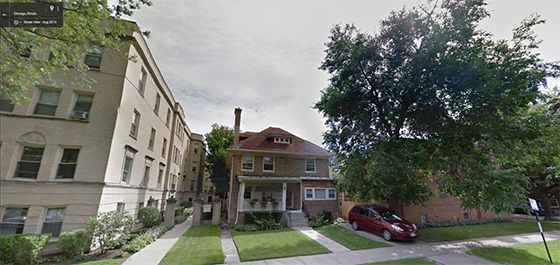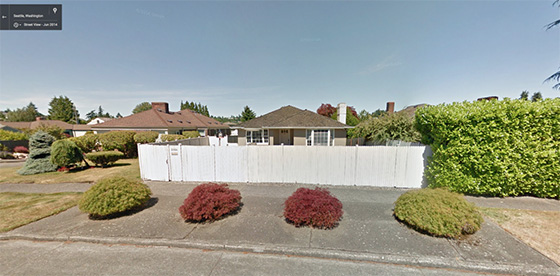| « The Tempest, Reimagined by Chicago Shakespeare, has all its Old Magic, and Even More | Arrived Deeply Uncomfortable, Left Somewhat Satisfied: EXPO Chicago 2015 » |
Art Tue Sep 22 2015
An Interview with Marc Fischer of Public Collectors: Hardcore Architecture

"Defoliants" Street View image, part of the Hardcore Architecture series by Marc Fischer.
Artists like Jon Rafman or Paolo Cirio, who work primarily with Google Street View as a medium, have created images that are evocative and disturbing, often blurring the line of legal privacy issues. While capturing the individuals who fill the streets, alleys and lawns of the world is captivating, these artists have drawn on the public and an additional tool to conceptualize the public sphere. Since 2007, the launch of the panoramic technology featured on Google Maps and Google Earth has become an eccentric and often easy way to view places one may never go or places one desires to see.
Enter Marc Fischer, his project Public Collectors, and his recent exhibition at The Franklin, Hardcore Architecture. I interviewed Marc before his opening reception via email correspondence.
Can you tell me a little bit about how Hardcore Architecture came into fruition? Are you into hardcore/punk rock music as well?
I am a fan of this music and started buying hardcore records and demos starting in around 1986. I can't imagine doing this project if I didn't actually like this stuff. In 2012, my wife and I bought our first house and for the previous year I was spending a lot of time on Google Street View, looking up houses from real estate listings before trying to see anything in person, much less look at the interior. I came to enjoy that as a way of trying to understand a place. Around that time I was reading a review of some underground metal band's demo tape in a magazine from the 1980s and it occurred to me to try plugging the contact address into Street View. I'm not sure what I was expecting to find, but I immediately realized that this would be a very different way of visualizing that history. I liked seeing where the bands I listened to came from. In some cases, I ordered things from these bands in the 1980s and these were the addresses where they received my mail orders or correspondence.
The houses are so ordinary most of the time, and I think the project calls up a lot of narratives that are under-represented in discussions of underground music culture. For example, behind many of these provocative band names, there are clearly a lot of really supportive parents who let their kids have a demo tape shipping operation out of their home, or a practice space in the basement or garage. Many band members were still living at home when they released the records and tapes that Maximum Rocknroll reviewed, but parental support isn't something that was particularly cool to sing about in hardcore thrash bands.
How many copies of MAXIMUM ROCKNROLL did you work with for this project?
The focus of the project so far has been the 1980s. Maximum Rocknroll began publishing in 1982 and there are 79 issues that span from the beginning until December 1989. I'm about 65 percent finished exploring back issues of the magazine. For copies I don't own, I've been going to the Harold Washington Library Center which, incredibly, has a complete run of the magazine that you can request from the eighth floor reference desk.

"Dehumanizers" Street View image, part of the Hardcore Architecture series by Marc Fischer.
You founded Public Collectors, a project that encourages the exhibition of cultural and media artifacts, and have published two books under the projects name. How did you become interested in archiving, collecting, and looking at artifacts?
Just one Public Collectors book actually, but now there are 18 booklets so far.
I've collected and saved things since childhood, and I definitely have a pretty hefty collection of records and zines. Being part of an artist group (Temporary Services) that makes a lot of publications and exchanges publications with a lot of other artists has definitely swelled the archives and forced me to think about what it means to save things made by others. I teach as well, and always have research I'm doing for my creative work. These things also lead to accumulations of "stuff" -- and I enjoy collecting as a creative endeavor all its own. I find the experience at most museums extremely antiseptic and predictable, which has compelled me to want to see and share more of the kinds of things that are typically squirreled away in people's homes. Museums rarely collect works made by collaborative artist groups, for example, and that's most of what I do, so if you want to see that kind of work, you have to look elsewhere.
I also desire conversations with other passionate people that save materials related to the histories I value. Offering your own resources can create more opportunities for those kinds of exchanges. Being able to access interesting objects is nice, but having direct encounters with the people that helped make those objects or are part of that history, is always richer.
 What's your favorite house/description/band name in Hardcore Architecture?
What's your favorite house/description/band name in Hardcore Architecture?
Oh, there are so many! I particularly enjoy the combinations where the band name is extra violent and the house is extra boring or ordinary. Some examples of this are: Dead Virgins, White Collar Corpse, Rotting Humans, Death Row, and Chicago's own Impulse Manslaughter.
How did you feel once you started looking up addresses and discovering that many of them were located in the suburbs?
This wasn't entirely surprising, although some of the houses are perhaps more grandiose than I expected. In many cases you can really feel the urge to break out of a quiet, sometimes rural, existence by making loud, ugly music. It becomes easy to imagine young people needing to invent their own fun when I navigate certain areas and see how little there appears to be. I grew up in a suburb of Philadelphia and started an underground music 'zine when I was 17 years old. Part of the impetus to do that was because I was pretty unexcited by my surroundings too. The people I went to high school with didn't care about the things I cared about, so I used my publication to find others that did. It worked then, and it still works.
Any exciting news for Hardcore Architecture or other projects that you have for the future?
Thus far I have completed three publications for the project: an essay booklet with color photos of the houses, and interview booklets with the photographer and filmmaker Bill Daniel and Les Evans from the band Cryptic Slaughter (whose childhood home is part of the project). I plan to continue searching for houses and making Hardcore Architecture publications. The next booklet will likely be an essay that focuses on the work of being a Google Street View driver, and the next exhibition of the project will take place at the Outhaus in Urbana, Illinois. Like the Franklin, it's a small backyard space behind the house of two artists. I'm trying to keep things domestic!
The exhibition at The Franklin, based out of Edra Soto's and Dan Sullivan's home in East Garfield Park, featured a selection of images and text from the overall collection of screenshots that the artist had accumulated since 2014. Rather than printing all of the pieces in color, the artist chose black and white for the majority of the exhibition, although a few images remained in color. The grittiness and angst ridden agitation that is incredibly singular to hardcore culture was characterized by the visual abrasiveness of the black and white and poor resolution quality. Additionally, Fischer's choice to tape the images to the wall of the gallery space symbolized the raw and radical DIY culture of zines, hardcore, and the underground. Many of the collected images were full of irony as they juxtaposed one another with location and place vs. title and review dialogue -- the works inform us that creativity can spawn anywhere, in a manicured lawn or in a city dwelling.
Hardcore Architecture will be exhibiting at Outhaus, October 3, at 709 E. Sunnyside Crest Dr., in downstate Urbana.








